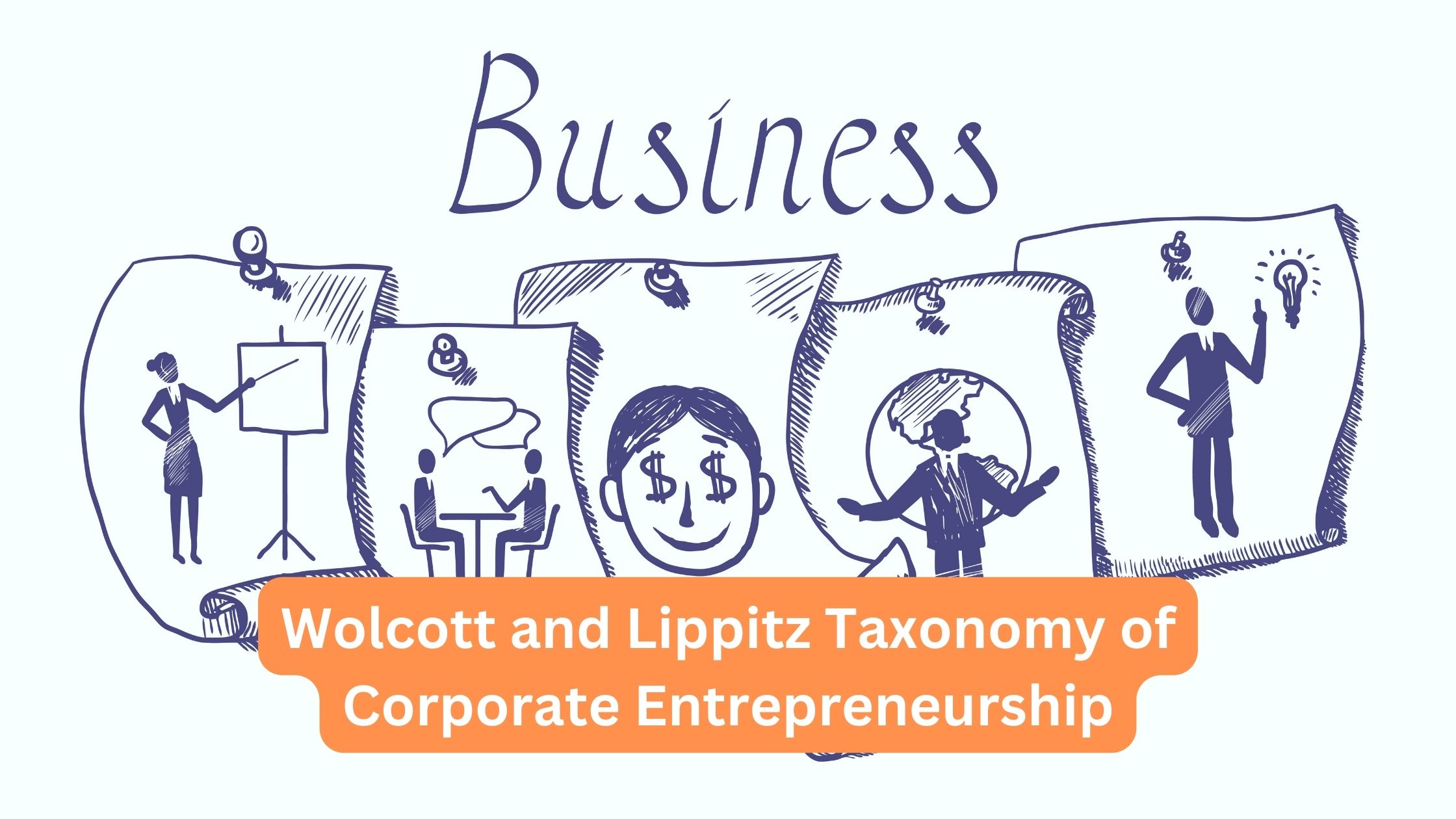Introduction: Understanding Corporate Entrepreneurship
In today’s dynamic business landscape, the concept of corporate entrepreneurship has gained significant traction. But what exactly does it entail? Let’s delve into the essence of Wolcott and Lippitz Taxonomy of Corporate Entrepreneurship before exploring its various models and implications in the current business environment.
Defining Corporate Entrepreneurship
Corporate entrepreneurship embodies the process through which teams within an established company conceive, foster, launch, and manage new businesses that are distinct from the parent company. However, these ventures leverage the assets, market position, capabilities, or other resources of the parent company. It’s crucial to distinguish corporate entrepreneurship from corporate venture capital and spinouts, as it involves significant internal resources and management by internal teams.
Exploring the Dimensions of Corporate Entrepreneurship
Corporate entrepreneurship extends beyond traditional product development, encompassing innovations in services, channels, brands, and more. Historically, companies have focused on innovations aligned with existing business functions, limiting their ability to seize new opportunities. Corporate entrepreneurship initiatives aim to overcome these constraints by fostering an environment conducive to innovation and risk-taking.
The Four Models of Corporate Entrepreneurship
Through extensive research, Wolcott and Lippitz identified four dominant models of corporate entrepreneurship, each characterized by distinct approaches to organizational ownership and resource allocation:
- The Opportunist Model
- The Enabler Model
- The Advocate Model
- The Producer Model
Each model offers unique strategies for fostering corporate entrepreneurship within organizations.
Understanding the Opportunist Model
The opportunist model represents the starting point for many companies venturing into corporate entrepreneurship. It relies on the efforts of “project champions” within the organization who pursue new business opportunities independently.
Example: Zimmer Holdings Inc.
Zimmer Holdings Inc., a medical device company, exemplifies the opportunist model. Surgeon Dana Mears proposed a novel approach to hip replacements, which received support from management and led to the establishment of the Zimmer Institute. Despite its success, the opportunist model’s reliance on individual initiative makes it unpredictable for many organizations.
Embracing the Enabler Model
The enabler model focuses on providing support and resources to employees across the organization, enabling them to pursue entrepreneurial opportunities within the company’s strategic framework.
Example: Google Inc.
Google’s renowned “20% time” policy exemplifies the enabler model, allowing employees to dedicate a portion of their work hours to pursuing their entrepreneurial ideas. This approach has fostered a culture of innovation and resulted in numerous successful projects within the company.
Harnessing the Advocate Model
The advocate model assigns organizational ownership for new business creation while providing modest budgets. Advocates serve as facilitators and innovation experts, collaborating with business units to drive corporate entrepreneurship initiatives.
Example: E.I. du Pont de Nemours and Co.
DuPont’s Market Driven Growth initiative illustrates the advocate model, where a dedicated internal group supports employees in developing and commercializing new business concepts. By providing assistance and guidance, advocates empower teams to navigate the complexities of corporate entrepreneurship.
Implementing the Producer Model
The producer model of corporate entrepreneurship involves establishing formal organizations within a company dedicated to driving innovation and new business creation. Unlike the enabler or advocate models, the producer model allocates significant resources and actively influences the allocation of resources within business units.
Key Components
- Formal Organizations: Companies implementing the producer model typically create dedicated entities, such as innovation labs or accelerators, to oversee corporate entrepreneurship initiatives. These organizations operate independently or semi-autonomously from existing business units.
- Dedicated Resources: The producer model requires substantial investments in both financial and human resources. Companies allocate significant budgets and staffing to support the development and scaling of new ventures.
- Cross-Unit Collaboration: Collaboration across business units is essential for the success of the producer model. Project teams may comprise members from different departments, leveraging diverse expertise and perspectives.
- Protection of Projects: The producer model aims to shield emerging projects from internal conflicts and turf battles. By providing a dedicated organizational structure, companies can create a supportive environment for innovation without the constraints of traditional business units.
Example: Cargill Inc.
Cargill’s Emerging Business Accelerator serves as a prime example of the producer model in action. The accelerator provides a platform for developing and scaling new business concepts that fall outside the scope of existing business units. With dedicated funding, expertise, and support, Cargill accelerates the growth of promising ventures and ensures their integration into the company’s broader portfolio.
Benefits and Challenges
Benefits: The producer model facilitates cross-unit collaboration, protects emerging projects, and creates pathways for executives to pursue new ventures. It allows companies to explore disruptive innovation opportunities while leveraging existing resources and capabilities.
Challenges: Implementing the producer model requires significant investments in resources and infrastructure. Integration of successful projects into established business units may pose challenges, and resistance from existing stakeholders could impede progress.
Selecting the Right Model
Considerations
Choosing the appropriate model of corporate entrepreneurship depends on various factors, including the company’s objectives, culture, and resources. Here are key considerations for selecting the right model:
- Strategic Objectives: Companies should align their choice of model with their strategic goals. Whether the objective is cultural transformation, accelerated growth, or disruptive innovation, the selected model should support the overarching strategic vision.
- Organizational Culture: The existing organizational culture plays a crucial role in determining the feasibility of different models. Companies with a culture of innovation and risk-taking may find the opportunist or enabler models more suitable, while those with a more traditional approach may opt for the advocate or producer model.
- Available Resources: Resource allocation is a critical factor in model selection. Companies with ample financial and human resources may be better positioned to implement the advocate or producer model, whereas those with limited resources may prefer the opportunist or enabler model.
- Risk Appetite: Consideration of risk appetite is essential in selecting the right model. The opportunist model entails the highest degree of uncertainty and risk, while the producer model offers greater control and structure but requires substantial investments.
Flexibility and Adaptability
Companies need to remain flexible and adaptable in their approach to corporate entrepreneurship. Depending on evolving market dynamics, internal capabilities, and strategic priorities, organizations may need to reassess their chosen model and make adjustments accordingly.
Continuous Evaluation
Continuous evaluation of the chosen model’s effectiveness is crucial for ensuring alignment with strategic objectives and driving sustained innovation. Companies should regularly assess the performance of their corporate entrepreneurship initiatives and make refinements as needed to optimize outcomes.
By carefully evaluating these factors and aligning the chosen model with the company’s strategic goals and organizational context, companies can effectively leverage corporate entrepreneurship to drive innovation and achieve sustainable growth.
Conclusion on Wolcott and Lippitz Taxonomy of Corporate Entrepreneurship
Corporate entrepreneurship represents a strategic imperative for companies seeking to navigate the complexities of today’s business landscape. By embracing innovation, fostering a culture of entrepreneurship, and leveraging internal resources, organizations can unlock new growth opportunities and maintain their competitive edge in an ever-evolving market.
FAQs
- Why is corporate entrepreneurship important for established companies?
Corporate entrepreneurship enables companies to explore new growth avenues, stay ahead of market trends, and adapt to changing consumer demands.
- How can companies overcome resistance to corporate entrepreneurship initiatives?
Effective communication, executive support, and a clear vision for growth are essential for overcoming resistance and fostering a culture of innovation within organizations.
- What role does leadership play in driving corporate entrepreneurship?
Leadership plays a crucial role in setting the tone for innovation, providing resources and support, and aligning corporate entrepreneurship initiatives with strategic objectives.
- Are there any risks associated with corporate entrepreneurship?
While corporate entrepreneurship offers growth opportunities, it also entails risks such as resource allocation challenges, internal resistance, and the potential failure of new ventures.
- How can companies measure the success of their corporate entrepreneurship efforts?
Metrics such as revenue growth, market share expansion, and the number of successful new ventures can help companies gauge the effectiveness of their corporate entrepreneurship initiatives.




